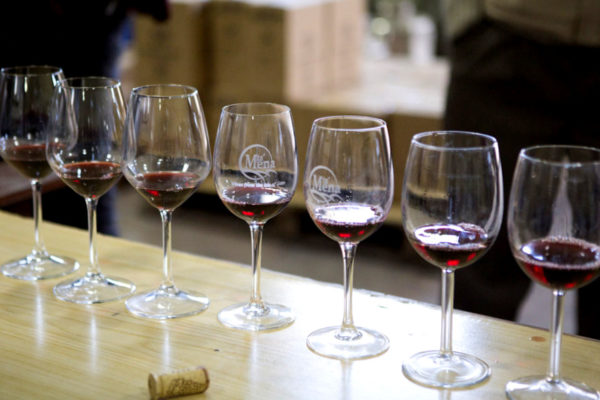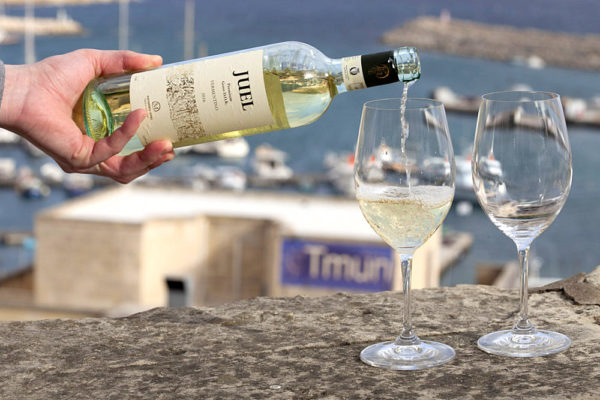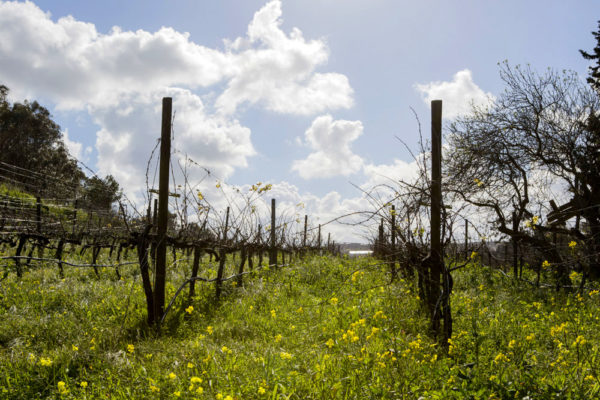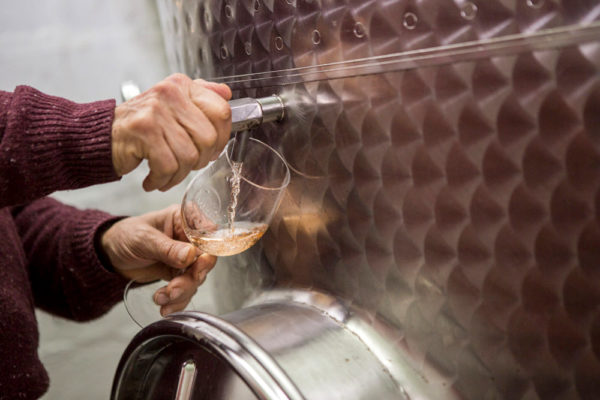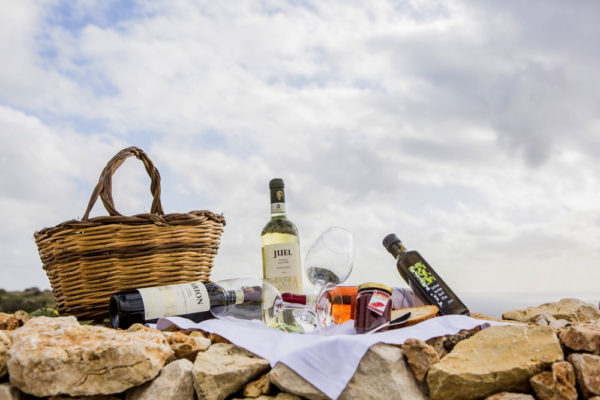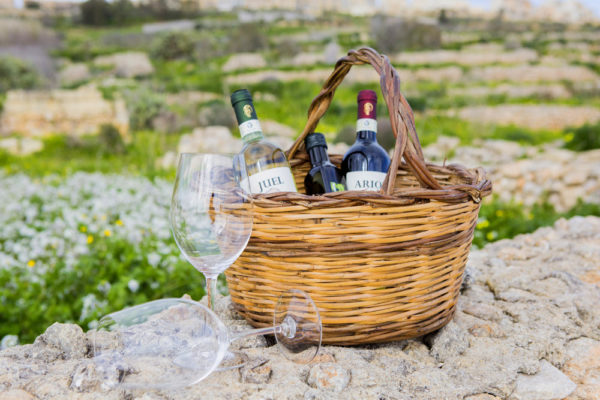We at Ta’ Mena Estate grow our own grapes to produce great wines with a particular Gozitan character. We are proud that most of our blends have been certified as GOZO D.O.K. Wines (Certified Denomination of Origin) which is the highest wine certification for Maltese wines.
Our wines are very delicate and well balanced. They are very fruity and full bodied, typical of our Mediterranean sunny climate and particular terroir. Actually our wines have the so called ‘Island Effect‘ presenting traces of salt on the palate.
Therefore when you are visiting Gozo come and enjoy our wines at Ta’ Mena Estate and we promise that you will not be disappointed!
Our wines are available from our shop at Ta’ Mena Estate, on the main road from Victoria to Marsalforn, Gozo and Ta’ Mena Winery, Triq l-Industrija, Ix-Xewkija, Gozo.
Marsamena Wines Range
The name Marsamena is inspired from the Marsalforn Valley where our estate is located and from the name of our late mother, Carmena Spiteri, better known as Mena. It is through her inspiration that we created these two fruity and full bodied wines that reflect the Gozitan character.
Ancient Gods Range
Inspired by our ancient history, still present in Gozo thanks to prehistoric temples and caves, this range reminds some gods of the Greek mythology namely:
- Aris – The God of War also connected to the Phoenicians.
- Juel – One of the Gods connected with the Ggantija Temples
- Arion – An immortal horse
- Zelus – the God of Rivalry and Envy
- Helios – The God of Sun
- Ceres – The God of Fertility and Agriculture
Winds Range
The particularity of our Gozo DOK Wines is due to the so called ‘Island Effect’ characterised by traces of sea-salt blown into our vineyards by the different winds coming from all directions.
We have named these wines after some of the most important winds namely:
- Tramont – the North Wind
- Gregal – the North East Wind
- Sciroc – the South East Wind
Table Wines
We also produce various Red, Rosé and White Table Wines that will also meet the daily requirements of many wine lovers.
The Maltese archipelago is situated in the centre of the Mediterranean Sea and consists of three islands, namely Malta, Gozo and Comino. The main island is Malta with its capital city Valletta where the country’s administration is located.
Gozo is the second largest island of the Maltese archipelago. It is topographically different from Malta and is characterized by its flat topped hills and valleys. This geological environment has rendered Gozo Wines very particular and therefore they have a separate DOK protocol from that of Malta DOK Wines.
The two main Gozitan valleys are the Ramla and Marsalforn Valleys where Ta’ Mena vineyards are located. They pass through the island from the southern part to the northern coast creating a particular micro-climate that offers very well suited climatic and geological conditions for the growing of grapes for high quality wines. Gozo, as a smaller island, is more exposed to cool north-westerly and westerly winds thus having a temperate climate.
The soil element in all Gozo wines manifests itself as a very slight bitterness in the aftertaste, which contributes to character and specificity. In general, a good Gozo wine should show character, robustness as well as balance.
Indeed it is the latter characteristic which can render Gozo wines unique. Moreover, our wines present an island effect characterized by traces of salt which is a bonus as far as flavour enhancement of the wine is concerned.
Wine production in the Maltese Islands precedes the Roman domination of the Mediterranean and can be traced to the Phoenician/Punic period. This is clearly evidenced by recent excavations at Mgarr ix-Xini in Gozo with ancient wine presses dating back to around 1000 BC.
In 2007, Ta’ Mena Estate started to produce wine in our state-of-the-art winery, from grapes produced in our own estate. We continually control the process from the vine to the bottle by practicing rigid green pruning and traditional methods in our vineyard and the best wine producing practices.
The most important factor is CLIMATE. This is by far the major player in comparison to SOIL and ENVIRONMENT. It follows then that although the soil quality has its importance; its influence on quality is relatively minor.
- The Maltese climate falls in the warm temperate category, with rainfall usually in autumn and winter. Spring and summer are usually very low on rainfall.
- Temperatures average 13 deg. C. in winter and 30 deg. C. in summer. Frost is practically unknown, and summer temperatures over 35 deg. C. are very rare. Winters are rather short, and the warm season is long.
- Sunshine hours reach their peak in summer, but spring is also very generous on sunshine. The Maltese islands average 300 days of sunshine per year. A lot of sunshine, besides the obvious positive effect on quality, is ideal against fungal diseases.
- Rainfall average is 600mm annually, concentrated mainly in autumn and winter. Although on the one hand this necessitates irrigation in spring and summer, it also helps prevent fungal diseases like mildew during the growing season.
- Wind is an important player. Most of the topography of the Maltese islands is exposed to wind; sheltered zones are very hard to come by. Wind has its pros and cons. It is fortunate that the prevailing wind direction is on 80% of the time, so that as a problem it is quite predictable. The prevailing wind is northwesterly, and is characterised by being cool and dry. It is a bonus in summer, as it helps to keep summer temperatures in check. The dryness it brings about helps prevent fungal diseases. On the other hand strong winds in critical periods (e.g. bud break) can cause mechanical damage, and the inherent dryness exacerbates an already critically dry situation.
- Soil is highly calcareous and originates from sedimentary rock. The soil of the Maltese islands can be divided into three main types according to physical characteristics. Sandy soil (red) in the south, south east, south west and western areas; loamy soils (light grey) in the central area; clay soils (grey) in the north, north west and Gozo. pH is high, usually 7.8 or above. It is usually not very deep, in most cases averaging less than 100cm. The underlying rock therefore assumes a very important role. This consists, in most areas of friable limestone, which is porous and acts like a sponge thereby retaining a good amount of water from the wet season, which the plants can rely on during the dry spell.
- Environment is heavily influenced by the fact that the Maltese islands are relatively small and the coast is never further than around five km from any given point. Part of the reason why Maltese wines have a potential for strong flavours may be due to the enhancing effect of the salt influence. The proximity to the sea also generates beneficial night dew during the dry season, which helps mitigate the effects of dryness.

